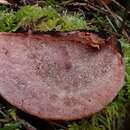en
names in breadcrumbs


Fomitopsis cajanderi is a widely distributed bracket fungus. Commonly known as the rosy conk due to its rose-colored pore surface, it causes a disease called a brown pocket rot in various conifer species.[1] It is inedible.[2] It is widespread in Western North America, with more prevalence in southern climates.[1] It has a particular preference for higher-altitude spruce forests.[1]
F. cajanderi is a perennial shelf fungus.[1] It may be identified by its small-to-medium-sized, fleshy, tough fruit-body, with a downy or crust-like top.[3] It grows to around 3–10 cm (1.2–3.9 in) wide.[4] The top surface is a pink colour becoming to grey, brown, or black, with a clear margin.[1] The inside of the conk and the bottom are a rosy pink colour.[1] The body of the fungus is rigid and can grow up to 1 cm thick.[1] There are 3–5 round pores per millimeter.[1]
This polypore is morphologically similar to its relative, Fomitopsis rosea. Other similar species include Fomitopsis pinicola, Ganoderma lucidum, G. oregonense, and Oligoporus placentus.[4]
Fomitopsis cajanderi is a widely distributed bracket fungus. Commonly known as the rosy conk due to its rose-colored pore surface, it causes a disease called a brown pocket rot in various conifer species. It is inedible. It is widespread in Western North America, with more prevalence in southern climates. It has a particular preference for higher-altitude spruce forests.
Cost capìtol a l'é mach në sbòss. Da finì.
A chërs an dzora a conìfere.
![]() A venta mai mangé un bolè trovà se un a l'é nen un bon conossidor dij bolè!
A venta mai mangé un bolè trovà se un a l'é nen un bon conossidor dij bolè!
As peul nen mangesse.
Fomitopsis cajanderi (P. Karst.) Kotl. & Pouzar
Cost capìtol a l'é mach në sbòss. Da finì.
AmbientA chërs an dzora a conìfere.
Comestibilità![]() A venta mai mangé un bolè trovà se un a l'é nen un bon conossidor dij bolè!
A venta mai mangé un bolè trovà se un a l'é nen un bon conossidor dij bolè!
As peul nen mangesse.
Fomitopsis cajanderi je grzib[10], co go nojprzōd ôpisoł Petter Adolf Karsten, a terŏźnõ nazwã doł mu Kotl. & Pouzar 1957. Fomitopsis cajanderi nŏleży do zorty Fomitopsis i familije Fomitopsidaceae.[11][12] Żŏdne podgatōnki niy sōm wymianowane we Catalogue of Life.[11]
Fomitopsis cajanderi je grzib, co go nojprzōd ôpisoł Petter Adolf Karsten, a terŏźnõ nazwã doł mu Kotl. & Pouzar 1957. Fomitopsis cajanderi nŏleży do zorty Fomitopsis i familije Fomitopsidaceae. Żŏdne podgatōnki niy sōm wymianowane we Catalogue of Life.